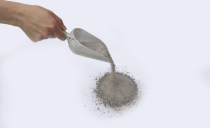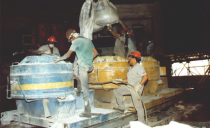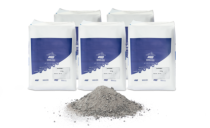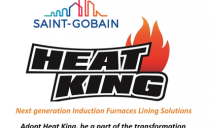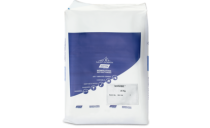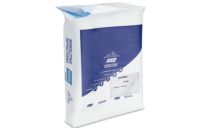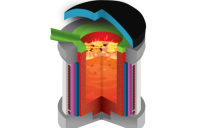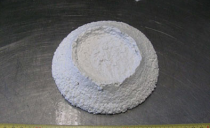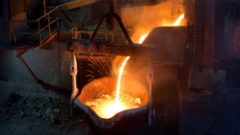
How Does an Induction Furnace Work?
An induction furnace is an energy-efficient, clean-melting furnace used to melt all type of metals such as steel, iron, copper, zinc and aluminum.1
Because an induction furnace does not require an arc, it is easy to regulate the melting heat, making it a suitable option for preserving valuable alloying elements. Moreover, this type of furnace generates a minimal amount of waste and pollutants, contributing to an overall reduction in carbon footprint.
During the operation of an induction furnace, refractory materials provide an essential barrier between molten material and the furnace induction system2. The diversified refractory materials supplied by Saint-Gobain Performance Ceramics & Refractories protect the furnace coil from ferrous and non-ferrous molten metals inside the vessel at high temperature. This protected lining is thus fundamental as a protective barrier against the most intense physical, thermal, and chemical stresses occurring during the operation.3
Principles of an Induction Furnace
Faraday’s Law describes how a magnetic field interacts with an electric circuit to generate an electromotive force, a phenomenon known as electromagnetic induction.4,5
Therefore, once a piece of conducting material — such as a charge or load within a furnace — is placed in an alternating magnetic field, an electric current is generated. As the current flows, it meets resistance and dissipates energy as heat via the Joule Effect.
Types of Induction Furnaces
There are two types of induction furnace, each fulfilling particular requirements:
Core-Type Induction Furnace
A core-type (or channel) induction furnace operates on the principle of a transformer — at mains frequency — whereby electric energy is transferred from one alternating circuit to another. In a channel induction furnace, an alternating current flows through a primary coil which surrounds an iron core.
A secondary coil is formed by a loop of molten metal, which surrounds both the core and primary coil. As current flows through the primary, it induces a larger current in the secondary, which then generates heat via the Joule Effect.
Maximum power transfer between the primary and secondary coils is ensured by concentrating the magnetic flux in the metal loop, ensuring up to 98% power efficiency. A drawback of a channel furnace is, because the metal loop must be continuously maintained, it is rarely permitted to cool.7
A channel furnace meets the needs of high throughput, high production operations requiring few alloy changes, and continuous casting schedules. Because of the constant operating conditions and temperatures, the operating life of refractory linings may extend over several years and thousands of operations. Channel furnaces are commonly used to melt single alloys, iron, aluminum, zinc, and copper.
Coreless-Type Induction Furnace
A coreless-type induction furnace also operates by transformer action. However, the secondary coil is dispensed with. The primary is a water-cooled copper coil that surrounds a crucible or refractory lining containing the metal charge. Thus, the primary coil induces a current directly in the metal charge.
One major advantage of the coreless induction furnace is that it can be shut down as required and started cold, significantly simplifying alloy changes. It can also be operated across a range of frequencies, starting from 50 Hz up to 10 kHz, offering unmatched flexibility.6,7
However, because of the absence of a flux-concentrating core, the power efficiency is reduced when compared to a channel furnace (a 75% power efficiency approximately). Smaller coreless furnaces operate at higher frequencies, maintaining their efficiency and promoting a vigorous stirring action.
Also, the frequent alloy changes — and recurring cooling and heating actions — may reduce the refractory lining operating life. However, coreless-type refractory linings are also significantly cheaper and quicker to change.
Refractory Lining in an Induction Furnace
Refractory linings play a pivotal role in the smooth operation of an induction furnace. Stable refractory linings result in optimal metallurgical performance. As a consumable material, a refractory lining undergoes degradation during the operational life of an induction heater.
Its operational life is known as its lining life and reflects the number of heat cycles it can sustain prior to repair or replacement. A stable refractory lining is expected to maintain, among others:8
- Low thermal conductivity.
- Resistance to corrosion.
- Resistance to thermal shock.
- Ease of installation.
- Ease of maintenance.
The suitability of a refractory lining depends on conditions such as slag formation, operating temperature, and furnace capacity. The type of slag produced during operation influences a large part of the choice of refractory material: for instance, silica would be used for acidic slags, magnesia for basic slags, and alumina for neutral slags.
The selection of refractory material is also influenced by other factors, such as:
- Scrap quality, size, and shape.
- Choice of alloying agents and additives.
- Holding time.
- Melting temperature.
Applications of an Induction Furnace
Some of the applications of induction furnaces in foundries, metalworks, and other industries include1:
- Alloy manufacturing, where induction stirring provides optimal uniformity and flexibility.
- Aluminum melting, where induction melting minimizes the energy required to convert alumina into aluminum and its alloys.
- Investment casting, where air and vacuum furnaces are used.
- Shrink-fitting, annealing, and brazing.
Refractory Solutions from Saint-Gobain
Saint-Gobain Performance Ceramics & Refractories provide a large array of refractory solutions to ferrous and non-ferrous foundries. This includes design, installation, supervision and process auditing for optimal performance. Saint-Gobain’s specialized induction furnace solutions enhance key factors impacting product quality while significantly reducing customers’ carbon footprints.
Related products
NORVIBE Dry Vibrated Cements (DVC)
NORVIBE™ dry vibrated cement mixes have been designed for ease of installation, outstanding service life and optimal metal corrosion resistance.
NORCAST® Castables
NORCAST™ castable range has been designed to offer easy installation, optimized setting time and outstanding service life in extreme operating conditions.
NORTOP Topping Mixes
Saint-Gobain Performance Ceramics & Refractories’ comprehensive range of NORTOP™ topping mixes is designed for use in the upper part of the induction...
HeatKing Monolithic Lining
HeatKing™ range of high performance refractory products are designed for use in extreme operating conditions, delivering enhanced performance.
NORPHOS Dephosphorization Solution
Patented NORPHOS™ technology is a simple refractory solution that enables every steel producer using coreless induction furnace to produce low phosphorous...
NORRAM Ramming Mixes
NORRAM™ range of wet and dry ramming mixes is adapted to accommodate a wide range of melting applications, particularly the relining and repairing...
NORPATCH Patching Mixes
Saint-Gobain Performance Ceramics & Refractories’ NORPATCH™ range includes a large choice of patching mixes for quick, efficient and long lasting furnace...
NORPLAST Plastic Mixes
NORPLAST™ range of ready-to-use plastic mixes can be applied by hand or using a pneumatic tool, allowing customers to easily build or repair a furnace...
NORCOIL Cement Mixes
Saint-Gobain Performance Ceramics & Refractories’ NORCOIL™ range of coil cement mixes is specifically designed to protect the coil in coreless induction...
Related content
Coreless Induction Furnace
Saint-Gobain Performance Ceramics & Refractories’ extensive portfolio of solutions for coreless induction furnaces supports customers to enhance safety and...
NORVIBE® Dry Vibrated Cements Case Study
Challenge: cements can be made with high-quality, pure raw materials that are engineered to achieve maximum performance
References
1. Shapet. How Does Induction Furnace Work? [online] Available at: https://www.shapet.com/knowledge-base/how-does-induction-furnace-work-
2. Ruh, E. (1991) Refractory Materials, Metallurgical In: Concise Encyclopedia of Advanced Ceramic Materials, Elsevier [online] pp. 394–402. Available at: https://www.sciencedirect.com/science/article/abs/pii/B978008034720250109X
3. Saint-Gobain. Foundry. [online] Available at: https://www.ceramicsrefractories.saint-gobain.com/refractory-solutions/foundry/coreless-induction-furnace
4. Inductotherm. What is Induction? [online] Available at: https://www.inductotherm.com/resources/what-is-induction/
5. Encyclopedia Britannica. Induction Furnace. [online] Available at: https://www.britannica.com/technology/induction-furnace
6. Chem Europe. Induction Furnace. [online] Available at: https://www.chemeurope.com/en/encyclopedia/Induction_furnace.html
7. Fanz-Huster, M. (2021) Selecting the Right Unit for Efficient Induction Melting. [online] Available at: https://www.foundrymag.com/melt-pour/article/21151955/selecting-the-right-unit-for-efficient-induction-melting-inductotherm-corp
8. Ispat Guru. Refractory Lining of Coreless Induction Furnace. [online] Available at: https://www.ispatguru.com/refractory-lining-of-coreless-induction-furnace
